|
|
Search for
The Famous Blonger Bros. |
|

July 2005
| 7/1/2005 |
Aftermath of the City Hall War
The Colorado state supreme court ruled that Governor Waite had the power to appoint Denver's police and fire board — even though they were municipal posts. The existing board was firmly in the pocket of Denver's gamblers, and Waite wanted a board that would actually arrest somebody.
The court also found that the governor was out of line in calling in the militia.
Most importantly, Waite would now have the power to shut down both gambling and bunco activities in Denver. Or would he? Hm?
Aspen Weekly Times, April 21, 1894
AN END OF GANG RULE
Commissioners Orr and Martin Step Down
and Out Yesterday.
HOW THE DECISION WAS RECEIVED
The Gambling Fraternity That Stood So Faithfully By the Gang of Dynamiters Are Trembling In Anticipation of the Fate That Awaits Them—Their Conspiracy Against Decency and Order Fails and Wih It Their Hope of Prosperity—The Political Machine Is Smashed.
DENVER, April 17.—The decision by the supreme court yesterday was a complete and conclusive victory for Gov. Waite and the new fire and police board. Commissioners Orr and Martin will vacate the board rooms at noon today without further controversy and both departments will be turned over to the new board. The belief is that under the decision of the court Messrs Orr and Martin cannot even bring a suit for damages in the district court on the ground that their removal was for political reasons. In fact there is strong intimation in the decision that Mullins and Barnes could ask for damages from Orr and Martin.
The most important matter remaining to be developed is the policy of the new board towards the gambling houses. The members of the board decline to state what course they will pursue, but a populist who stands so close to them that his utterances have almost the force of an ex cathedra dictum says that every gambling house in town will be closed.
"The program which is mapped out," said he, "is to shut every one of them and keep them shut. The governor and board are committed to that course and there will be no half measures. Lower Seventeenth street will also be cleaned of the bunco men who have infested it. All these people have been helping to hold up the old board with money and physical force. Jeff Smith will be arrested every day so long as he attempts to continue his present occupation. The district attorney may turn them all loose or refuse to prosecute if he likes, but the board will keep right on arresting."
"No, it is not intend even to center gambling in one locality under surveliance, at least not for the present. It may not be that business men's petitions will be received and then the subject will properly come up for consideration, though it is very doubtful if any petition will be granted. I tell you, too, that the best of the gamblers will be glad to have the present state of affairs ended. There is a whole breed of deputy sheriffs and leeches living off them and they are being bled to death. They couldn't stand it much longer."
Even though the board may not be so drastic as this political light expects, there is no doubt it will adopt stringent measures.
Commissioners Orr and Martin said they would leave today. They met during the morning and renewed some saloon licenses. A couple of officers were kept on guard in the board rooms as usual all day.
Commissioners Mullins and Barnes were of course elated and Mr. Barnes had a handshaking matinee with Mayor Van Horn. Commissioner Mullins said the board would assume its duties fully and would give all its efforts to securing reorganization upon a basis which would give efficient service and satisfy the public. They were very busy with the detail work of selecting men, etc.
Auditor Gird says that the authority of the old board to draw warrants will be recognized so far as he is concerned up until noon today. He does not think there will be any difficulty about the officers or men getting their pay. The only hitch might arise from the mayor refusing to sign the warrants and it is understood his honor will not refuse. There will be some question about the pay for the past two weeks of the ten men discharged by the old board for refusing to sign the agreement.
The republicans of the gang could not find anything too bitter to say of Justice Elliot. They stood on the street corners and declared that it was politics that put him on the supreme bench and that rightly or wrongly, law or no law, he should have stood by the old board and the gang. They said they would stand united to defeat his renomination for his present place.
Now that the row is over one of the men most deeply concerned says that the puzzle to everybody connected with the case is: What was the cause of the governor calling out the militia so suddenly? When the chief executive went to Colorado Springs that day it was understood by the attorneys and all others interested, that the governor in person would go to the city hall the next morning with the new commissioners and make a demand for the offices. The governor went to Colorado Springs and participated in some exercises at Colorado college library. Late that night, after returning to Denver, he peremptorily ordered the militia to report at the armory at noon next day. It is now surmised that the governor must have suffered some slight or snub at Colorado Springs, which has never been made public and which led him to make up his mind to take prompt action for the assertion of his dignity and prerogative.
|
| 7/2/2005 |
Paquette
Today we heard from Rose DeRocher, related to the Shullsburg Paquettes. The Belonger family's oldest brother Simon married Emily O'Neil in Shullsburg. Her mother's first husband was Antoine Paquette. The Paquette name can still be found in Shullsburg.
Rose tells us Sam DeRocher was in Leadville in 1879, and she has photos! The folks in the photos are largely unidentified, but we can hope, can't we? She'll be sending scans.
1879 was a big year for the Blongers. Simon, Sam and Lou and little Marvin were apparently in town. Sam ran for mayor that year. Lou was running a theater company in nearby Georgetown. Simon and Marvin were involved in mining, as always. Simon served briefly as a state assemblyman and for a time as superintendent of the Robert E. Lee mine around that time. By 1882, Sam and Lou were in New Mexico, but 1879, 1880, they were in the area.
So who knows?
|
| 7/4/2005 |
Van Tassel's Balloon
Here's Scott's optically-corrected version of the Van Tassel ascent in Albuquerque.
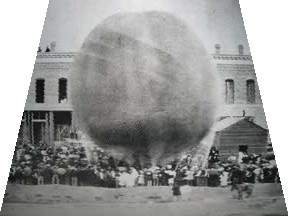
Sox Byland
Yesterday we heard from Marion Parker of Texas, who purchased the portrait below at an antique shop with the idea that he might return the photo to the man's family. Just a little research turned up our page of Blonger gang mugshots.
What do you think?
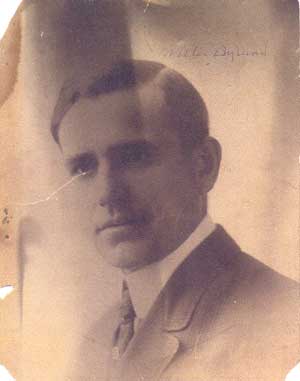
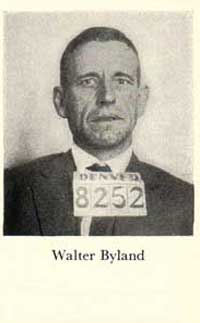
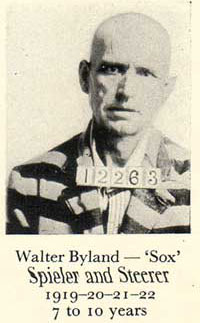
We know next to nothing about Byland. We believe he was born in 1888, and that he was a graduate of MIT — his wife was a college grad as well — and a good athlete. Where, oh where did he go wrong?
City Hall War
Here's an article published shortly after the confrontation in Denver, which summarizes the critical events very succinctly.
Castle Rock Journal, March 21, 1894
WAR'S HORRID FRONT
DENVER AN ARMED CAMP.
Governor Waite Calls Out the Militia to Oust the Recalcitrant Police Board—Cannon Trained on the City Hall.
Denver was shaken from center to circumfrence Thursday the 15th by wars and rumors of wars.
The contest over the positions of the Fire and Police Board of Denver had reached a critical stage. The preceeding facts are as follows:
Governor Waite on the 8th removed Orr and Martin from the board because they protected gambling. He appointed Barnes and Mullins in their places. Orr and Martin refused to vacate. The governor threatened to drive them out with the militia. Orr and Martin appealed to the District Court, and Judge Graham issued a temporary injunction forbidding the executive from interfering with them. Governor Waite and his attorneys held that the court had no right to restrain the state's chief executive from doing what he considered to be his duty.
The morning papers made public the startling fact that Governor Waite had ordered the infantry, artillery and signal corps, Colorado National Guard in the city to report at the armory at 1 p.m. It was generally believed that his intention was to disregard he injunction of Judge Graham and attempt to forcibly remove Messrs. Orr and Martin, the old members of the police board from its office in the city hall and install the new board, Messrs. Rogers , Mullins and Barnes. The supposition proved to be correct for at 2 o'clock the militia was ordered to move on the city hall under Adjutant General Tarsney. Colonel Hogle was relieved from the comand as he was feared to be disloyal to the governor's cause. The force consisted of the Chafee Light Artillery with two Gatling guns and two twelve-pounders, the signal corps mounted on bicycles and the infantry, the whole force numbering about 200 men. The column accompanied by a great crowd of curious citizens moved down from the armory at 26th and Curtis streets to Fourteenth and Lawrence, one block from the city hall. The cannon and Gatling guns were unlimbered and pointed toward the city hall.
During this time the other side had not been idle. The police force had all been concentrated in the city hall, armed with rifles and shot guns and given orders. The sheriff also being in sympathy with the old board had pepared to take a hand by swearing in a large force of deputies, said to number 200, who would be used to support the court's injunction and help defend the old police board. Some of these deputies were of the worst class of tough citizens. It being generally understood that the new board if installed would put a stop to gambling, the gambling fraternity were very ready to lend all the aid possible in defense of the old board. It was stated that besides ordinary arms the forces at city hall had a supply of dynamite on hand to use as a last resort if an attack was made upon them.
Such was the condition of affairs at 9 o'clock.
But attempts at an adjustment of the controversy had been in progress. Committees of citizens and a committee of leading business men representing the Chamber of Commerce labored with the two sides to secure a compromise of some sort that would prevent the opening of hostilities.
The lawyers for the opposing sides had not been idle and were in consultation all day. The attorneys for Orr and Martin asked the other side to submit to the Supreme Court the question whether the governor had the right to call out the militia, as he had done. Barnes and Mullins refused to accept the proposition. They wanted the Supreme Court to decide the whole question as to who should hold the office. Orr and Martin would not consent to have the question of their rights thus hurriedly passed upon. It has been stated that the object of Orr and Martin was to keep the case in the courts as long as possible, they holding on to the offices until it was settled.
The governor had advised the officers to delay an attack on the city hall pending these negotiations, but at five o'clock the attorneys for Orr and Martin refused to discuss the matter further.
But Governor Waite had decided that the force of the militia at his command was not sufficient to cope with the formidable forces within the city hall and he did not give the order to fire. Instead he appealed to General McCook at Fort Logan, ten miles from the city for United States troops to help keep order in the city. General McCook responded in person, accompaned by 300 men who were encamped near the depot for the night. It was explicitly stated by General McCook that he came not to interfere in the contests, but to assist in maintaining order in the city.
Governor Waite, having decided that he needed a larger force before beginning an assault on the city hall, ordered the militia back to their barracks. He then caused General Tarsney to issue an order to the National guard at Leadville, Aspen, Boulder, Pueblo, Grand Junction and Durango to hold themselves in readiness to proceed to Denver if ordered to do so on Friday. General Tarsney said that fully 1,300 men would be under arms on Saturday in Denver—800 regulars and 500 extras.
Late in the afternoon the attorneys for Orr and Martin applied to Judge Graham, who had issued the injunction, to order the arrest of Governor Waite for contempt. Judge Graham refused, however, to sign the writ, saying that he did not believe that the governor intended to be vicious in this matter. He said he would wait for further developments.
This was the situation when the citizens of Denver went to bed on Thursday night.
|
| 7/5/2005 |
A True Pioneer
Here's a curious sidebar: a vicious murderer in Australia claiming as his defense that he was abused as a child — in 1892!
Aspen Weekly Times, April 9, 1892
Deeming, the Moral Monstrosity
MELBOURNE, April 7.—In an interview which he had with his solicitor to-day, Deeming supplied Mr. Lyle with abundant material for his defense at the coming trial. The facts which he gave dated from the time of his birth and include much information regarding his infancy. During his conversation with the solicitor the prisoner remarked: "The world produces moral as well as physical monstrosities." The line of defense which will be adopted at the trial is probably that Deeming's nature received a malignant impress prior to his birth which marked all his actions during his life, and has left him mentally incapable of overcoming the homicidal impetus with which he has been afflicted, in fact that he was what the prisoner himself had deemed as a "moral monstrosity." After the coroner's jury found Deeming guilty of murdering his wife the date of his trial was fixed for April 21st.
Deeming killed, or had killed, his wife and children, and then the new bride with whom he had run away. His legal strategy, by the way, was a failure.
|
| 7/8/2005 |
Google Earth
Do you have a beefy computer? I could say a lot about the free program Google Earth, but the pictures say quite a bit. These aren't separate views. The navigation is continuous over "real" distances. Just type in a destination and it "flies" you there.

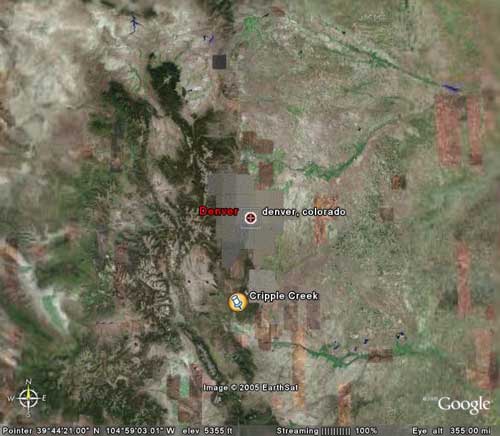
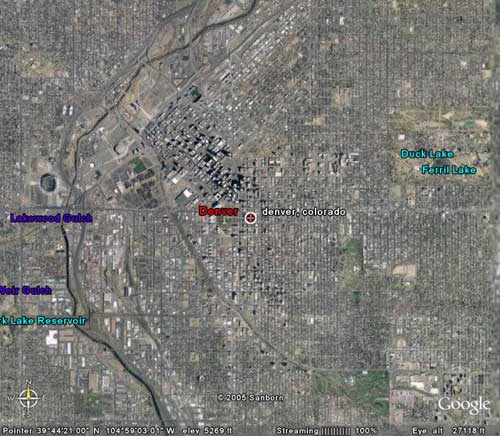
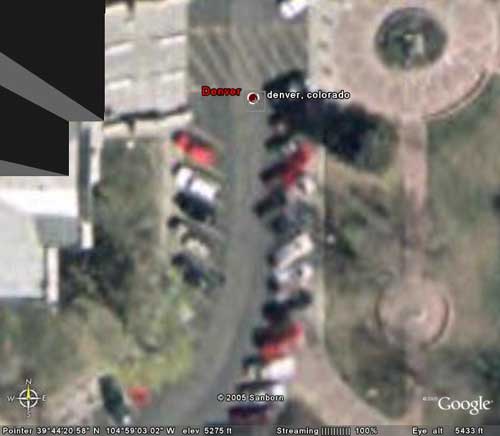
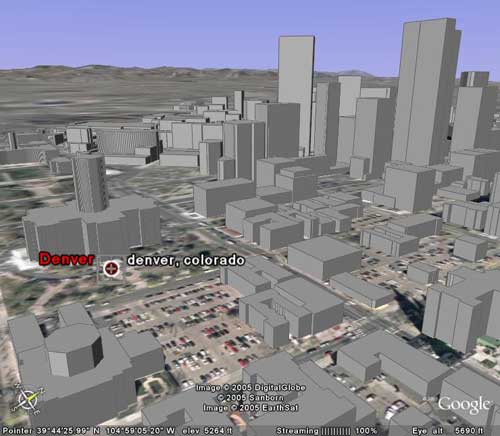
This last one is a view of Cripple Creek, Ironclad Hill to the right, near the Forest Queen mine, and Pike's Peak.
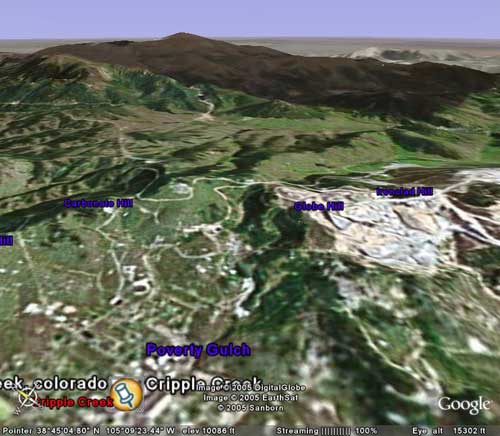
Rise of the Blongers
We have been spending a lot of time lately at Colorado's Historic Newspaper Collection, trying, finally, to understand what happened in 1894. First the state militia lays siege to Denver City Hall, after which the state Supremes allow the governor to shake up the city fire and police departments. Next, all the merchants of vice are forced to close down their gambling houses and brothels.
Soon after, miners strike in Cripple Creek, and the local sheriff — acting in the interests of mine owners like Sam and Lou — raises an army to break the strike, and the governor once again calls in the militia. Some blood is shed.
After the strike is settled, the officer in charge of the militia is tarred and feathered outside Colorado Springs, and an investigation begins. And who should be accompanying the detectives but Lou Blonger.
In short, the Governor of Colorado went to war — quite literally — with the Cripple Creek mine owners and the Denver establishment, which was a wholly-owned subsidiary of the local gambling fraternity. Soapy Smith was quite obviously the leader of Denver's gamblers at the time, but the Blongers were in ascendancy, and owners of a prosperous mine as well, so the story is also theirs. By 1895, the Blongers were in charge and Soapy was laying low, so the details of this story may well shed ever more light on their actual rise to power.
We have many pages of printouts, and over time we will transcribe some of these and add them to our new section called Rise of the Blongers. Although the Blongers are rarely mentioned in these articles, we hope over time to show that the Bros. played an important role in this chapter of Colorado history — how could it be otherwise? Time, and research, will tell.
Rest In Peace, Soapster I do believe today is Soapy's Wake in Hollywood.
|
| 7/12/2005 |
WOLA We'll be leaving for NM on Saturday, and back the next weekend. Hopefully we'll have a good show and tell.
Take This Ballot Box and Stuff It, Part I
Just like police chief Hamilton Armstrong, detective Leonard DeLue keeps popping up in research on Denver in the 1890s.
Do you remember DeLue? As chief of detectives, deputy sheriff, and later as owner of his own agency, DeLue was seemingly Lou's good friend. In 1920, Van Cise met with Lou at DeLue's urging — and Lou's subsequent attempt to bribe Van Cise may have ultimately been a motivating factor in Van Cise's investigation. We'll look at him in more detail at some point, but for the moment we'll just share this item from 1897.
Aspen Weekly Times, April 10, 1897
YESTERDAY'S ELECTION
The Election of the Entire Taxpayer's Ticket in Denver Conceded.
SILVER DEMOCRATS WIN IN CHICAGO
Electing Carter Harrison, jr., Mayor By Fifty Thousand Majority—Big Majority For The Citizens' Ticket in Leadville—From Other Cities in Colorado—Riots In Denver.
Denver, April 6.—The republicans and everybody else concede that Mayor T.S. McMurray and the entire taxpayers' ticket was elected in today's election. This is the first time that any mayor has succeeded himself in the city of Denver. Mayor McMurray will have a clear majority of at least 5,000 over his opponents.
There were two incipient riots tonight. Shortly after 7 o'clock Deputy Sheriff DeLue attempted to force two men on the judges of precinct 8, third ward, alleging that they were watchers. The judges claimed that the men had not proper credentials, and declined to admit them. DeLue and his two friends then attacked the place. DeLue kicked in the window, while the others tried to break into the door. Somebody called for the patrol wagon, and the officers arrived just in time to prevent a riot.
Shortly after 9 o'clock Bat Masterson and police officer Tim Conners had a shooting match at 1835 Champa street, a polling place. Masterson appeared with a deputy sheriff's commission, and demanded a place in the polls to watch the count. Conners, who had been elected as special constable by the judges, was requested to eject Masterson. He ordered Bat out, and, after some words, Masterson opened fire with his revolver, firing several shots. Conners is said to have replied in kind. Masterson then ran, and has not since been heard from. A number of citizens are scouring the city to capture him. Fortunately nobody was hurt.
I'm sure this is one of Bat's favorite stories. But where, oh where are the Blonger boys?
He'd enjoy this one too:
Fort Collins Courier, May 5, 1881
A. Updegraph, a Dodge City bartender, was fatally wounded a few days ago by Bert Masterson, an Arizona tough.
|
| 7/14/2005 |
Stay Tuned We'll have plenty to tell, I hope, after our research trip to New Mexico next week, but there are a few other big items in the pipeline, so don't stray too far.
Bat "Bert" Masterson Here's a look at Lou's pal Bat and Bat's buddy Wyatt:
Aspen Weekly Times, December 5, 1896
REFEREE WYATT EARP.
He Is a Man of Nerve, and His Decisions Are Usually Just.
SAN FRANCISCO, Dec. 3.—Wyatt Earp, the referee in the Fitzsimmons-Sharkey fight, who has made the unpopular decision, is an old Dodge City man, of the days when Bat Masterson ran the town. There were three brothers of them, all gun fighters, and all men peaceably inclined would walk over into another county to avoid them. After the decadence of Dodge City the brothers went down into Arizona, where they became known as the "Earp gang," and speedily worked up a fued with a neighboring outfit. In the resulting fight one Earp was killed, and Virgil had one hand shot off. The remaining brothers then went to California. Vrgil is city marshal of Colton, Cal., a position that only a man of nerve can hold, and Wyatt had been known all over the state. While residing in southern California he frequently refereed fights along the mexican line, on supposed neutral territory. The favorite place was Tia Juana, just over the line. Earp always made the men fight, too. There was no sprinting when he was referee; the men must get out in the center and give and take. Wyatt is a man with a cool, clear head, which he never loses, and his decisions have heretofore been considered as just and equitable.
Earp is well known all over Colorado and is said to have lived in Salida. A few years ago he was mixed up in a murder case, for which he stood trial. He is given credit with having killed thirteen men.
Earp and Masterson occasionally worked fights together. Masterson was BMOC in Colorado on the subject of pugilism — as a referee and timekeeper.
Castle Rock Journal, December 30, 1898
Gamblers Flocking to Havana.
New York, Dec. 24.—A dispatch to the World from Havana, says:
On the heels of the announcement that Jim Corbett will open a saloon here, comes the news that Bat Masterson, Wyatt Earp of Tombstone, A. T. "Doc" Holliday, Ed Casey, "The Kid" of Skaguay, Alaska, and "Doc" Brown of Spokane, are coming to Havana to engage in various enterprises.
Judging from appearances, the early history of the Western towns of America will be repeated in Havana.
Gambling houses will be opened everywhere. It is a poor business street which has not had bids on it for a location for an American bar. That seems to be the idea among the sporting fraternity that Havana will be made another Monte Carlo, to endure through the reconstruction period, at least.
Lou was said to have had operations in Havana, but no specifics. The evidence indicates his con men sometimes worked Havana in the winter, but this article suggests other types of business and pleasure that would have been tempting for the Blongers.
Daily Journal, June 7, 1902
Bat Masterson Arrested.
New York, June 7.—Bat Masterson with two confederates were arrested on complaint of Geo. H. Snow, son of the late president of the Mormon Church, for running a crooked faro game in which Snow lost $16,000. The three men were released on bonds of $1000.
$16,000. 3 x $1000. Do the math.
Daily Journal, June 9, 1902
Bat Masterson Fined Ten.
New York, June 9.—Bat Masterson was fined $10 today for carrying concealed weapons. The charge of having gambling instruments in his possession was dismissed.
Elbert County Banner, December 15, 1905
It is reported that Bat Masterson, well known in Denver and throughout the west as a dead shot with a big number of notches on his gun, is to be appointed to the secret service at the White House.
Just goes to show how forgiving folks could be if you were good with a gun.
|
| 7/15/2005 |
Telluride Daily Journal, October 25, 1921
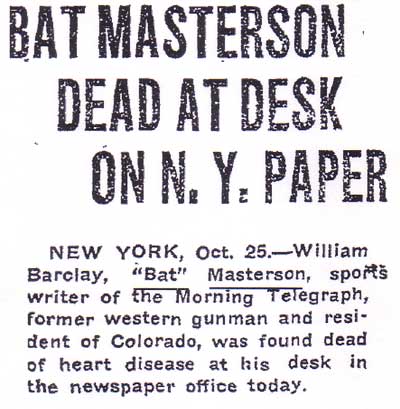
Speaking of Havana, years ago I found this booklet, printed in 1936, behind a drawer in a house I was painting. The name Otero, we must assume, is only a coincidence.
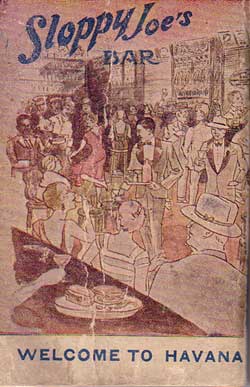 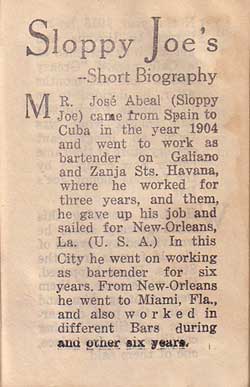
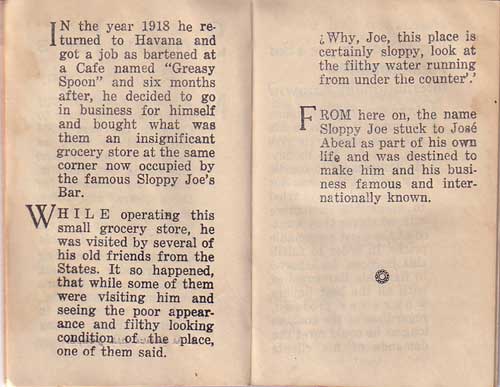
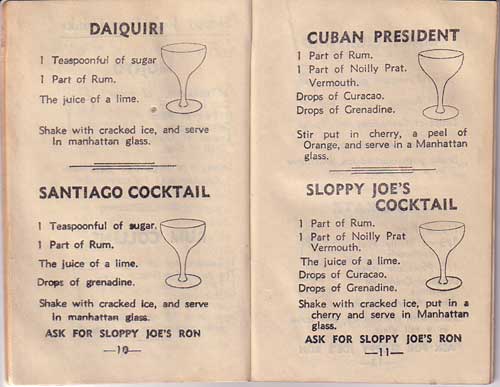
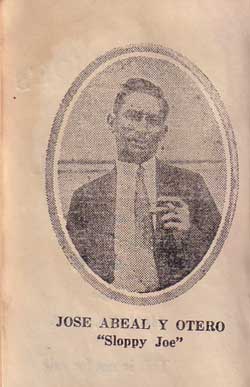
|
| 7/21/2005 |
The Blonger Posse
Let's start off by announcing the opening of a new section on BlongerBros.com, The Blonger Posse, dedicated to the boys and their exploits in the Southwest in the 1880s. Plenty more to come.
WOLA 2005
This year's Western Outlaw Lawman History Association conference in Santa Fe is over, and even though we are still in New Mexico, there's so much to tell I thought I'd get a head start on my report. An extensive photo album will follow shortly.
First, a few words about the fine folks we met this week. Though no one had any earthshaking Blonger news to impart, everyone went out of their way to make us feel welcome. They listened attentively to our tale, and shared with us their various passions, and offered their support. Thanks to everyone for a wonderful time. We have made many new friends, and know they will assist in any way they can should they come across new information.
The flip side, of course, is the realization that, if most WOLA members are unfamiliar with the Blongers, we have a long way to go to bring them back to the historical table. But then, that's our job.
Now, a word or two on some of the most significant encounters we had this weekend:
Authors Mark Dworkin & Chuck Hornung are two names that have appeared here on several occasions. These gentlemen have in the past been very helpful, particularly in analyzing Sam and Lou's relationship to Wyatt Earp's Vendetta ride — something we take for granted at this point though the evidence itself (the so-called Otero letter, primarily) is still under consideration.
Here's Mark, Chuck and Scott talking Earpology on the porch of the old Harvey House along the tracks in Las Vegas, NM.
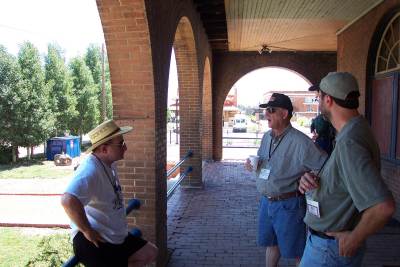
We enjoyed talking with both of these noted Earp authors and researchers immensely, and deeply appreciate both their assistance and friendship. Chuck, who has a special interest in New Mexico's Mounted Lawmen, actually found the Otero letter tucked into the pages of the governor's autobiographies. Mark was recognized this week for an article in the WOLA Journal about New Mexico merchant Henry Jaffa that also discussed the Otero letter in that context.
Robert K. DeArment is author of Knights of the Green Cloth and Bat Masterson, one of the few authors to acknowledge Lou Blonger as a member of the West's gambling fraternity, and as such has our gratitude. It was a pleasure to meet him and have a chance to discuss the boys.
Here's author Bob Alexander, who gave a talk on the wild side of life in Silver City, NM, where we found that Lou claimed to have spent time in the 80s with gamblers Frank Thurmond and Lottie Deno. Hell of a speaker, and a true Western gent. Bob was honored for his book Lawmen, Outlaws and S.O.Bs.
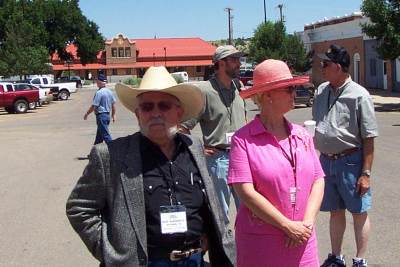
With him is author Jan Devereaux, who is researching gambler Carlotta Thompkins, alias Lottie Deno, thought to be the model for Gunsmoke's Miss Kitty. We'll be researching Lou's time in Deming/Silver City soon, and have promised to share any new info on Lottie if she'll do the same for the Blongers. Jan was honored for her article on Thompkins/Deno.
Author Karen Holliday Tanner, treasurer of WOLA and a not-too-distant cousin to Doc, recognized our names on arrival and did a great job of making us feel at home, introducing us to WOLA members she thought might be most helpful to our project. Thanks, Karen.
Here she is in Las Vegas standing before the former location of Doc's saloon in that town.
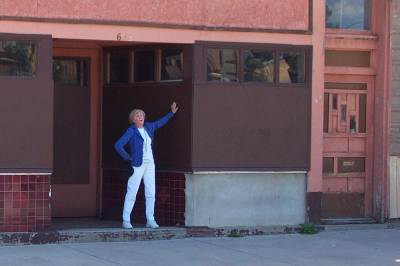
Karen's interest in western lore began when she inherited a box of memorabilia from her father simply labelled "Doc." What fun. I wish. She is now an intrepid researcher and accomplished author herself, along with her husband and collaborator author John Tanner, and hooked for life.
Author Marcus Gottschalk, who gave us all a tour of historic Las Vegas, is a human dynamo of a speaker. Among his many projects he has served as consultant for documentaries and is renovating period buildings in Las Vegas. Here's Marcus, on the left, in Anton Chico.
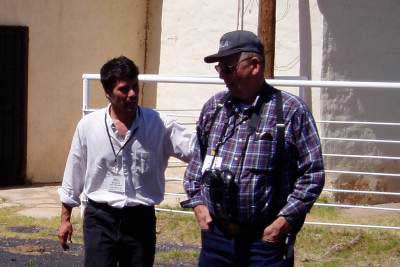
Much, much more to come...
|
| 7/22/2005 |
WOLA Highlights
Back home tomorrow. Tonight, a few memorable moments from WOLA and our week, then tomorrow we'll get back to the real meat, our latest Blonger Bros. discoveries.
WOLA began with a few cocktails and the opportunity to meet some of our fellow WOLA members, as described in part last night. The party was held in a private home in the hills belonging to a gentleman with an incredible collection of Western collectibles. This was the good stuff.
The ice in the margaritas, I am told, was crushed with the mallet used to crush the skull of a colleague of Butch and Sundance during a train robbery gone bad.
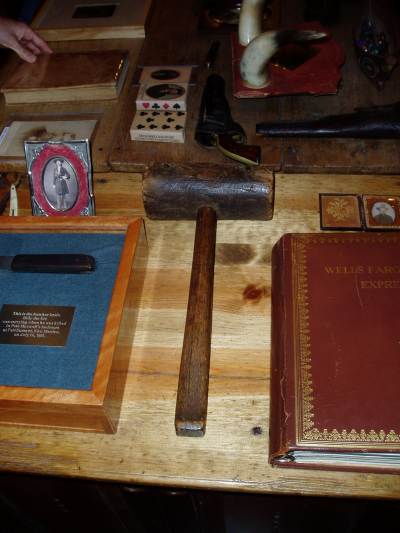
It was suggested that the limes be sliced with Billy the Kid's knife, but cooler heads prevailed.
A Billy the Kid field trip took us to Las Vegas, with a tour by Marcus Gottschalk. Here's the Plaza Hotel where lunch was served.
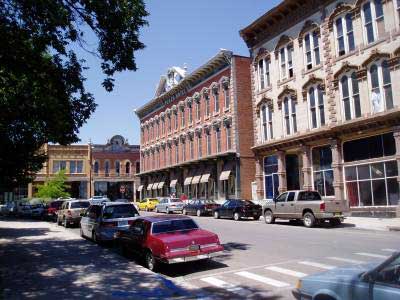
Not far from here is the site of Doc Holliday's saloon. The original building is no more.
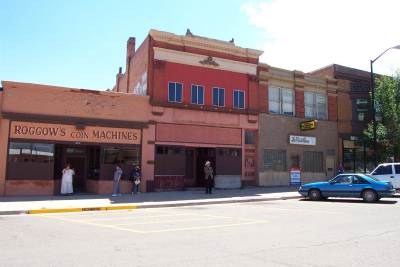
Here's the Castaneda Hotel, also home to the local Harvey House, where young girls could wait tables and experience the West in a relatively safe, structured environment.
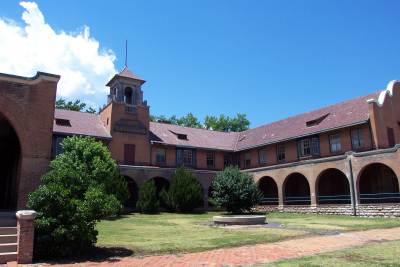
Then on to Anton Chico, deep in the mountain desert, across the Pecos, where Billy and his gang could relax in seclusion amongst the locals. Here's the local church.
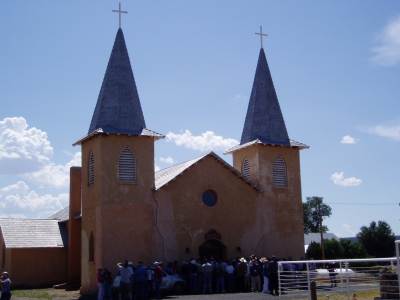

The padre, taken by surprise, was more than happy to share a little history.
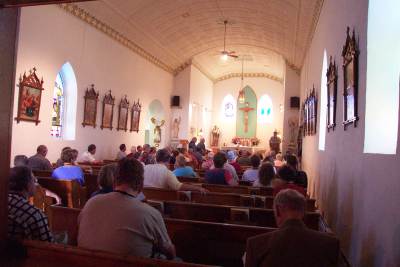
In Anton Chico, Chuck Hornung introduced us to Joe Newton, a great Earp fan. It took a moment for Scott to realize that Joe, who was on our bus, was none other than the winningest cross-country coach in Illinois high school history. Scott and he had indeed met previously at IHSA track meets. Small world. That's Joe, center.
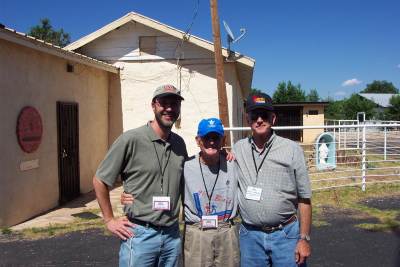
Then a stop at a museum near Glorietta, and buffalo burgers for lunch.
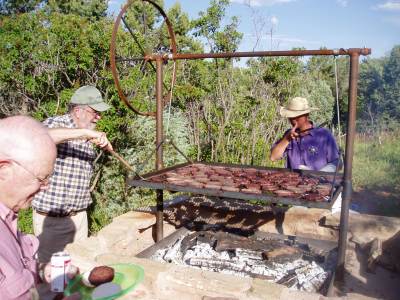

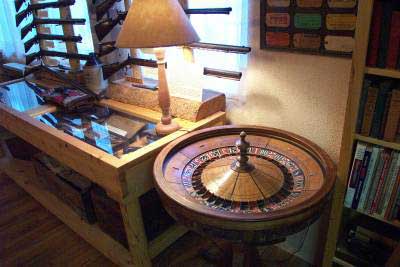

Yes, they had lots and lots of guns, including antique ray guns and BB guns.
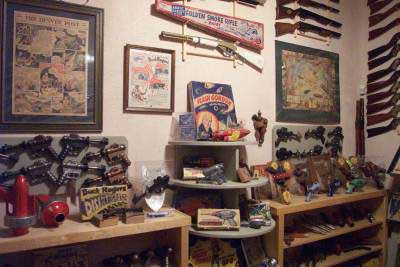
Here's a hog oiler. Take a guess. That's Bob DeArment taking a break from the heat.
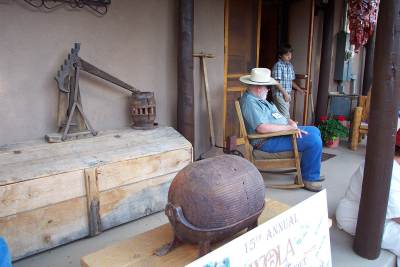
While at the museum we made the acquaintance of fellow WOLA member and Denver lawyer Larry Reno, who as it happens, knew his father's friend Philip Van Cise well enough to call him Phil. Though he knew the Colonel had penned a book, he had not heard of Lou Blonger, the book's subject. On perusing Fighting the Underworld, he realized he personally knew most of the Denver cops listed as having participated in the arrest of the Blonger gang. Again, small world, folks.
Here's Tom Moy. Tom has dedicated himself to uncovering the history of the West's forgotten Chinese outlaws. No bull. What a great subject, one with which we can identify. We wish him all the best.
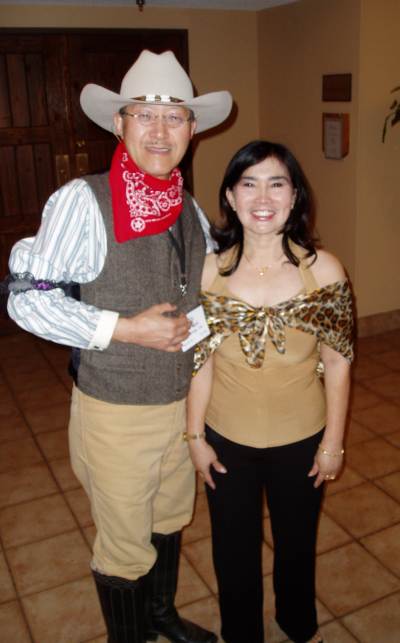
Up next, the fruits of a week's research, and a Blonger Tour of New Mexico. Much to tell! Too much, in fact...
|
| 7/24/2005 |
WOLA 2005: Joe in the Cerrillos Hills
Our first engagement upon arrival in New Mexico was to meet with Bill Baxter, an expert on the Cerrillos area, to learn about the hills where Joe spent many years prospecting and mining. If there is anyone who knows more about this area and the people who lived there, he just may know too much.
Here's Bill pointing toward Bonanza Hill, where Joe spent some ten years mining.
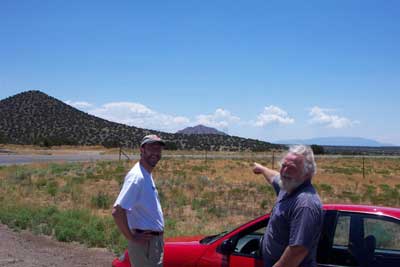
The first thing Bill did was hand us a map of all Joe's claims, and a printout detailing the claims he worked and other information about his time there.
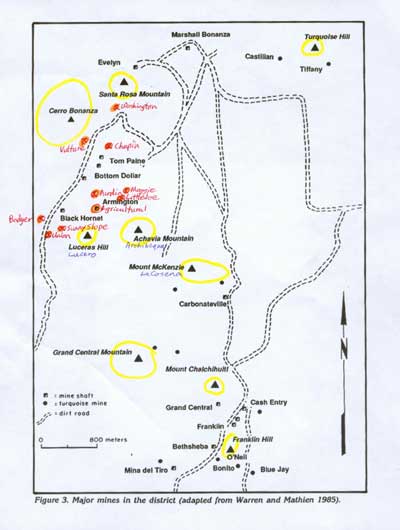
Joe was one of some 1000 miners who descended on the area around 1879, wresting control from the Spanish landowners through sheer force of numbers. Joe may have made his way there after failing in the Black Hills, though this is undocumented.
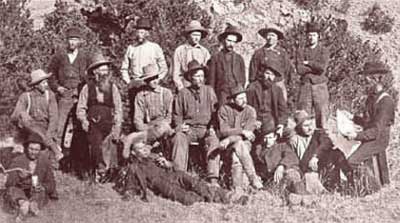
The Cerrillos Hills are a cluster of small mountains that represent the remanants of a 30 million year old volcano. Indians were quarrying turquoise here as early as 700 AD. Then came the Spaniards, and finally the Anglos in 1879 who came in search of gold and silver, the white man's turquoise...
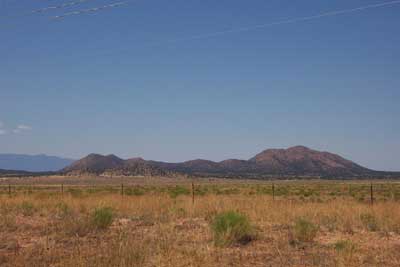
I am here, fortunately, to tell you that it is indeed hot as hell in them thar hills in mid-July. We scouted the area for a couple of hours, and it's a darn good thing Bill brought water for us to carry in, or your humble correspondent might currently be slowly mummifying in the New Mexico sun.
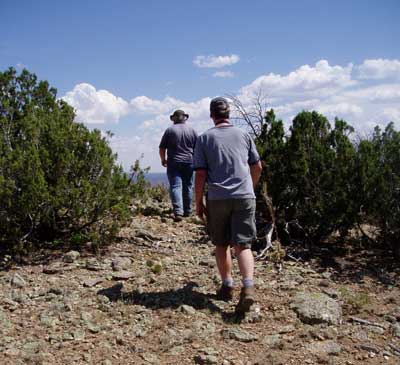
This is Carbonateville, which was for a short time one of the largest towns in New Mexico. Joe would certainly have come here for supplies, recreation and companionship. The road is the old Highway 10.
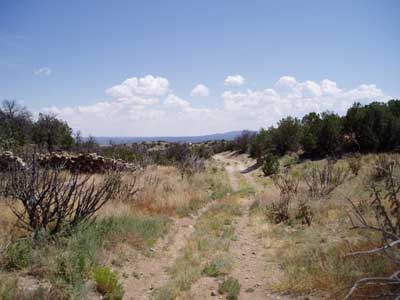
About all that's left now are the walls of the hotel, and a well up the hill that never hit water.
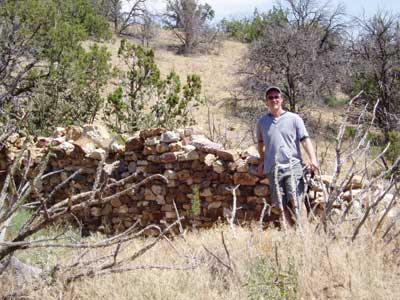
This is a typical mine in these parts, just a hole that goes eighty some feet straight down.
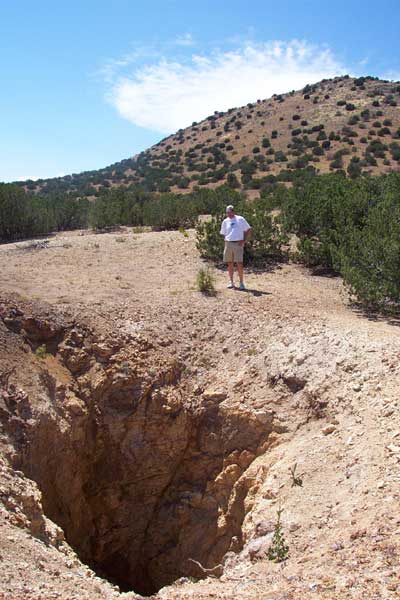
There were around 5000 holes dug in these hills, and Joe worked a number of them. In his early years there, he had some stake in the mines he worked. He disappears from the records about the time Sam and Lou are in Albuquerque, then returns. We really have no evidence he was in Albuquerque aside from a visit in March of 1882, but who knows?
In later years, Joe seemed to be working for others. Why the change? Did he just find himself craving a day's wage? A claim holder had to dig ten feet in a given year to hold a given claim. Often mines would stand unworked till the end of the year, and then a flurry of activity would assure the claims would be valid for another year. Joe often appears on documents in the late Eighties as a witness to the required digging.
Long before the "Colorado Miners," the Indians worked these hills for valuable turquoise, and the area was perhaps the continent's premier source for centuries. You can see that this distant hill is scarred on one side.
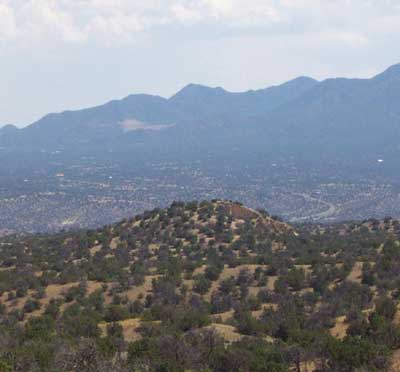
Over hundreds of years the local tribes excavated the entire hillside in search of the stone. Here we are at the base of the excavated hillside. It's thought the Pueblos dug some 100,000 tons of rock here.
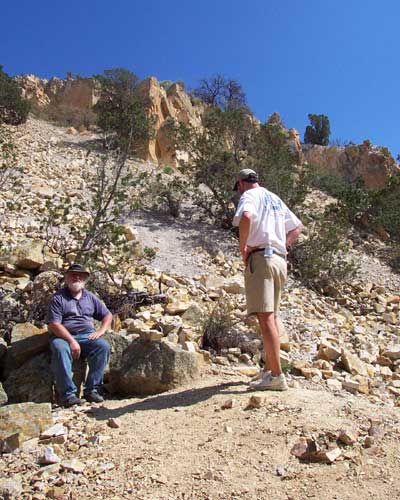
Here's a turquoise mine being worked currently.
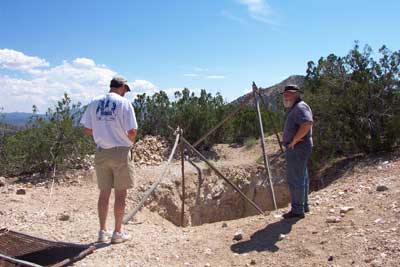
Bill says that most of these mines were dug in search of silver, but turned into gold mines when it came time to sell. The vast majority were worthless claims. Some mines were later worked for galena, lead, zinc.
The Cerrillos boom only lasted about five years, but Joe remained in the area much longer. A marriage license we found in Santa Fe has Joe, at the age of 54, marrying widow Carrie Viles in 1902. We had thought her name to be Clara Biles as stated on Joe's military pension survey, which also stated that Carrie's maiden name was Windsor. Census data indicates she was from Vermont, Joe's birthplace.
This is Allenville Penitentiary, not far from Cerrillos and Santa Fe.
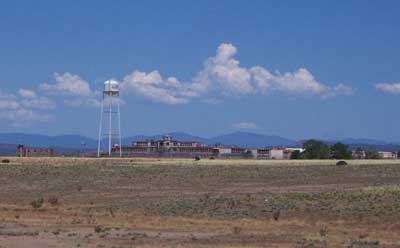
In 1891, six prisoners escaped. They were all recaptured, but for the ringleader, who was killed. Several guards were fired, and replacements hired. According to the Albuquerque Daily Citizen, November 5, 1891, Joe was one of the men hired, and stated that he had done such work before. Prison guard, huh? We should find out who was in the can at the time.
Allenville was the location of the original version of The Longest Yard with Burt Reynolds.
Still to come, Sam's old beat in downtown Albuquerque, "Prof." Van Tassel and Albuquerque's first balloon ascension, a new prostitute mystery, and Marshal Sam gets some assistance from his modern day successors.
|
| 7/25/2005 |
An Overdue Word on Pronunciation
When I first saw the names Belonger and Blonger, I assumed, as you may have, that they were pronounced like the word "longer," as in "This page keeps getting longer and longer."
Not so. Here are your three options:
Scott and I use what we believe to be the Americanized pronunciation, which rhymes with conjure.
If you're feeling French, give it that continental sound, blohn-zhuh.
Or if you're a cheesehead, you may say like some still say Belonger in the old home town, be-lahn-jee.
WOLA 2005: Sam's Beat in New Albuquerque
Albuquerque was established by the Spanish in 1706, and was an important crossroads even then.
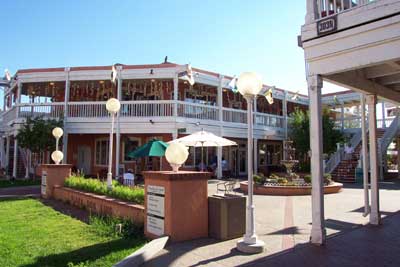
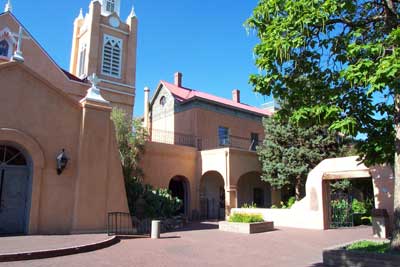
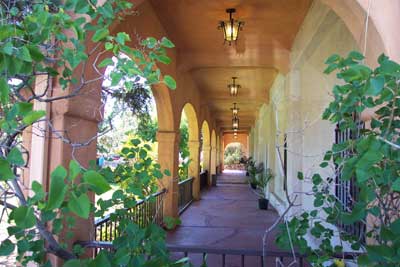
When the railroad arrived in 1880, it passed within a couple of miles of what became known as Old Town. The cluster of businesses and homes that sprang up around the depot was called New Albuquerque, or New Town, and that's where Sam was marshal, and Lou his deputy. By 1882, there were fifty telephone subscribers in town, and a mule-drawn streetcar ferried citizens from New Town to Old and back again.
This is the Casa de Armijo, now a restaurant, on the plaza at Old Town. Good food.
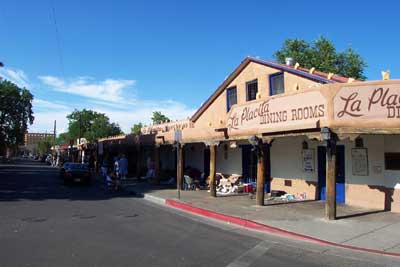
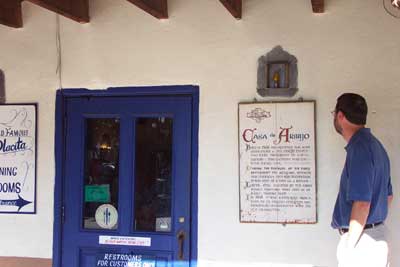
Despite these conveniences, New Town was a true western town, rowdy, bustling and dangerous at times. Not long after Sam left office, Milt Yarberry was hanged for shooting a man in cold blood and planting a weapon on him, which he is thought to have done twice while serving as Albuquerque's first marshal.
There were no murders in Albuquerque during Sam's six month stint.
Railroad avenue, which crossed the tracks near the depot, was the main drag in New Town. This is the depot.
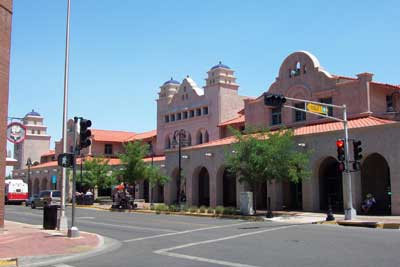
Sam sent many a "vag" on his way here, including Big Ed Burns, sending his troubles down the tracks to the next town and the next marshal. Today Railroad Ave. is called Central.
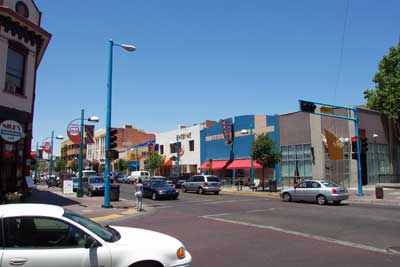
It was, in fact, part of the old Route 66. So we might then say that Sam and Lou were getting their kicks on Route 66 eighty-odd years before Martin Milner.
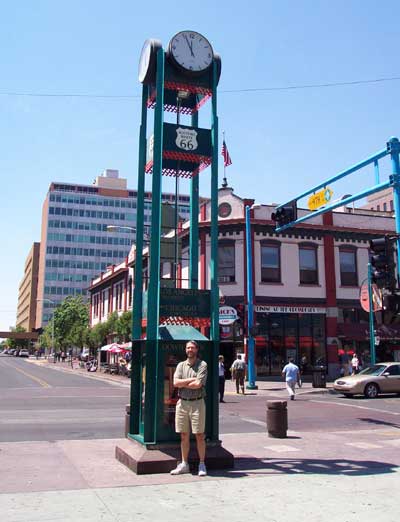
This is Central and 4th, the old red light district, where Lou's woman had her bagnio.
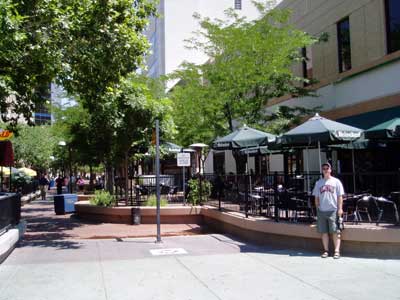
This is where Sam, Albuquerque's fifth city marshal, and brother Lou his deputy chased horse thieves, got shot at, and where Lou pistol-whipped poor old Prof. Van Tassel. It's a pedestrian mall now.
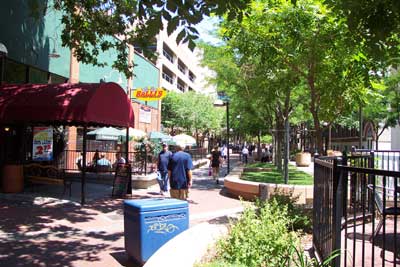
We ate lunch on the corner. We were thinking this might make a great second location for our fake Blonger Bros. restaurant. No?
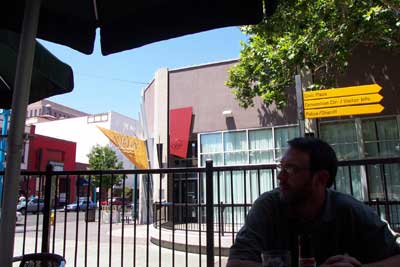
On second thought, maybe the place hasn't changed that much.
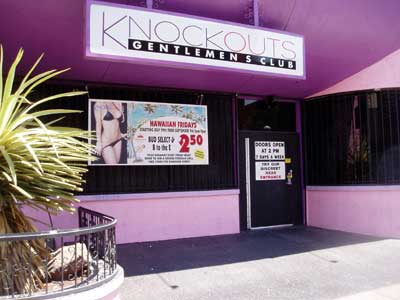
Coming up: Van Tassel and an ungrateful city, a second soiled dove, and Sam's Beautiful Badge.
|
| 7/26/2005 |
WOLA 2005: The City of Albuquerque and the city of Albuquerque
Do you remember bartender Park Van Tassel, popularly known as The Professor? He owned the Eilte saloon in New Albuquerque, and on July 4, 1882, he became the first man to fly in the state of New Mexico, taking to the air in his brand new hydrogen balloon, The City of Albuquerque. The ascension was timed to coincide with the opening of Albuquerque's first gas production facility.
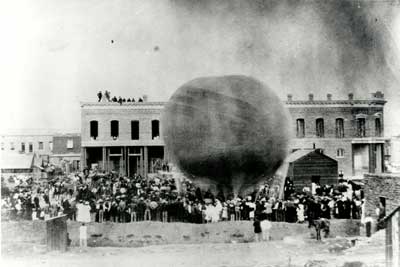
A few months later, after a night of drinking, Park would accompany Lou Blonger to the 4th St. brothel run by Lou's "woman." Here, after an indiscrete remark, Lou clubbed the Professor, whacked him the business end of a long revolver, cocked the hammer, and threw it to the mixologist's chest, bellowing "You s— of a b—, you can't talk to my woman in that way."
Here I am standing near the spot where Park's balloon took off, on 2nd between Gold and Central.
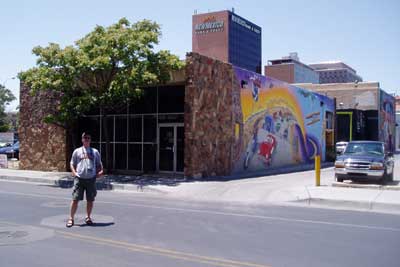
Today Albuquerque is known as the balloon capital, not of America, but of the world. The city is home to the Albuquerque International Balloon Fiesta, and the state's license plates are even adorned with a balloon.
Now look at where I'm standing.
No plaque. No monument, or marker.
Now look behind me. See that mural? A very beautiful mural, one of many around downtown. But NO BALLOON. Come on, Albuquerque! Get it together!
But there's more. According to an 1881 article in the Albuquerque Morning Journal, Park was in fact already a veteran balloonist by the time of his New Mexico ascension. His original balloon, the Hercules, had begun to rot, so a new balloon was ordered from San Francisco at a cost of $500, a sizeable sum.
Just up Central, amid miles of decaying Route 66 motels, is the 7-11 where the runaway bride was found.
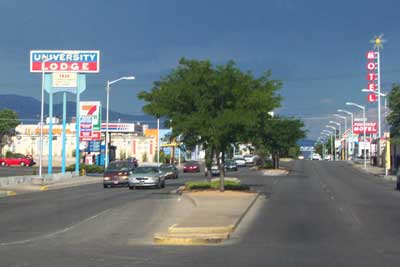

Your humble correspondents, Scott and Craig Johnson.
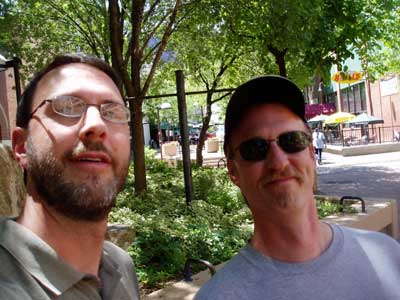
Welcome to Albuquerque.
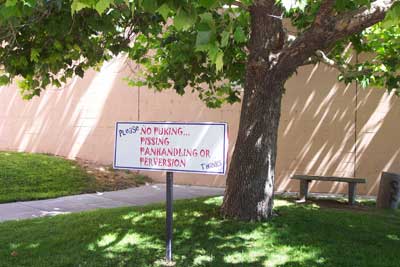
Coming - Mollie Blonger and Sam's badge. And more still.
|
| 7/27/2005 |
WOLA 2005: Sam's Badge
As you may recall, in researching the Albuquerque newspapers, we came across two articles describing a gold badge given to Sam by a grateful community. We since had heard that the badge, accompanied by one of Sam's pistols, was in the possession of a collector, but the identity of the current owner remains a mystery.
Enter Detective Jeff Arbogast of the ABQ PD. A veteran of the Albuquerque force, Det. Arbogast is responsible for the creation of a new museum honoring the department's history for Albuquerque's 300th anniversary next year — and he's a badge collector as well. He's putting out an APB, and has sworn an oath to track down these historic items. He has our gratitude for doing so. You're okay in our book, Jeff.
We don't intend to acquire these treasures (though it would be nice if they came home to Albuquerque), but we would at least like a look, or a photo. I'd love to know what Sam carried.
Sam was fifth marshal of Albuquerque, but he and Lou both worked as private detectives in that area for a short time, for the Rocky Mountain Detective Association, and perhaps with their own agency. Might either one have done work for the railroads or Wells Fargo as Wyatt Earp did? They apparently claimed to have worked on the "construction of the Denver & Rio Grande railroad."
Livingston, I presume?
Sam Blonger had an unretrieved letter in Albuquerque, January 15, 1882. This told us that Sam was in town at least two weeks before being appointed marshal. W. Livingston is on this list as well. This is interesting because Lou and William Livingston went way back to their days in the Civil War.
Bill visited Lou while he convalesced after injuring his leg in Tennessee. Lou and Sam eventually joined Bill at his family home in Mt. Carroll, Illinois. Sam married Bill's sister Ella in 1866. Then the Livingston family, with Sam and Lou, moved to Red Oak, Iowa, then on to Salt Lake City. Sam would remain married until 1889, but this tells us Bill was still in picture. He must have been a quiet one. Did he leave any letters? A diary?
For that matter, Lou corresponded with William Pinkerton for many years, Van Cise said. Are his letters still in existence?
The Truth About Sam
Sam was described as a big man with a fiery temper. This article describes in graphic detail what had only been insinuated before.
Albuquerque Evening Citizen, May 8, 1893
SAM BLONGER.
His Wife in Denver Seeks Divorce for Cruelty.
Samuel H. Blonger, who in the early days of Albuquerque, was marshal of the city and had a wife here at that time, appears to be in hot water with his Denver wife, as the following extract from the Republican would indicate.
Attorney Edward Ring, in behalf of Sadie J. Blonger, began suit yesterday afternoon in the county court for divorce from Samuel H. Blonger.
The complaint charges a system of extreme cruelty toward his wife practiced by Blonger for the past three years. They were married October 30, 1889, in Denver, and she charges that on February 10, 1890, while they were residing at 1524 Lawrence street, her husband, who is a powerful man, weighing two hundred pounds, without provocation assaulted her, and so inhumanly maltreated her that she was under the care of a physician until the following April.
Again, in January, 1891, while living at 1744 Larimer street, she charges that he came home at 3 o'clock in the morning in an "advanced state of intoxication." She was in bed at the time, and she declares that he seized her by the hair, dragged her from her bed and kicked and beat her into a state of insensibility.
Assaults of an equally brutal character are charged against the defendant in March, October, May, and June, 1892.
She states that after the assault in 1892 she left him and began a suit for divorce, but, upon his earnest professions of reformation and promises to treat her kindly in the future, she dismissed the suit and returned to him. They continued to live together at 835 Eighteenth street until April 30, 1893, and on that evening, while entertaining a party of friends and in their presence, she charges that in a fit of rage, without any provocation, he committed an inhuman and brutal assault upon her, striking her down and leaving her in a maimed and disfigured condition, so much so that she is still under the care of a physician. After this assault she left him finally.
Mrs. Blonger alleges that her husband is possessed of property to the amount of about $15,000, and that his income averages $300 a month and that she has no means of support, her health being so impaired that she is unable to earn a livelihood. She asks for a divorce, an allowance from her husband's property for support, alimony pending the suit, attorney's fees and an injunction restraining the defendant from disposing of his property or incumbering it until the determination of the cause.
Judge Burns granted a temporary injunction as prayed for.
Sam wasted no time after his divorce from second wife Sadie, promising himself to Jesse Wheat, then reneging and marrying Virginia Pierrepont two months later.
Albuquerque Evening Citizen, Dec. 29, 1893
JESSE WAS JILTED
She sues Samuel H. Blonger to Recover $25,000 Damages.
Jesse Wheat has been jilted and she is not happy. Samuel H. Blonger is the man who she says disappointed her, and she thinks the anguish of mind that she has suffered by his cruel action is worth just $25,000. She has sued Mr. Blonger in the district court to recover this amount. In her complaint she alleged that the defendant on Aug. 1 last promised to marry her and that he renewed his promise at various times since then. Recently, however, his manner changed and he refused to marry her. Blonger's first wife obtained a divorce from him on the grounds of extreme cruelty some time ago.
The above is from the Denver Times. Mr. Blonger was marshal of Albuquerque in the early days. While here Sam was regarded as a very pleasant gentleman but bad associates in Denver no doubt ruined him.
|
| 7/28/2005 |
WOLA 2005: Lou's House of Soiled Doves
Surely you recall Kitty Blonger, the Arizona prostitute who in 1888 shot Charles Hill in the head after he burst into her room at the back of a Peach Springs saloon, surprising her in bed with Kid Fay. A few days later, "L. Blonger" attended her trial in Kingman. Though charges against the Kid were dropped, the high-priced lawyers remained to defend poor Kitty, who was acquitted. Kitty was the second woman to be tried for murder in Arizona.
She shows up again in Aspen in June of 1889, two months after Lou's divorce from wife Emma Loring, and five months before he married Nola Lyons. Then in 1893, she had an unclaimed letter at the Deadwood PO.
But who was she? A wife? A common-law wife? But whose? The name Blonger is seemingly unique to the five western Blonger boys and their families, then as now. And again, according to news accounts of his knockdown with Park Van Tassel, Lou was involved with an unnamed Albuquerque madam in 1882.
But there's more.
Albuquerque Evening Citizen, February 27, 1888
Kitty Blonger, a sporting woman formerly of this city, killed a man named Hill, at Soda Springs, Arizona, a few days ago.
This connection to Albuquerque bolsters the case that Kitty and the Blonger Bros. have a history, but still doesn't solve the riddle.
The next quote appears a mere three days after Kitty's acquittal:
Albuquerque Evening Citizen, April 9, 1888
Court Proceedings.
Territory vs. Mollie Blonger; maintaining a nuisance; pluries writ ordered, and scire facias.
Ah so. Mollie Blonger, not Kitty. Another prostitute named Blonger, and this one's still in Albuquerque. We are told that whores sometimes took the surname of their "procurer" — more as an alias than a married name. Any more out there?
Sandia Mountains
Speaking of soaring through the skies of New Mexico, here was Scott's view of the Sandia Mountains on our way in to Albuquerque.

Here, on the other hand, is a nearly identical view using Google Earth. It wasn't really that hard to match it up, either.
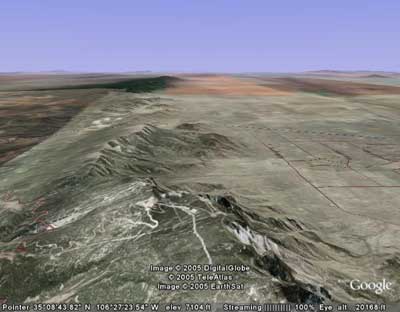
Notice the switchback roads in the images above. Those lead to an impressive little park with a view of both sides of the range. We visited here on our last evening before returning to the prairies of Illinois. Here's the view of Albuquerque to the west.

This is south along the range.
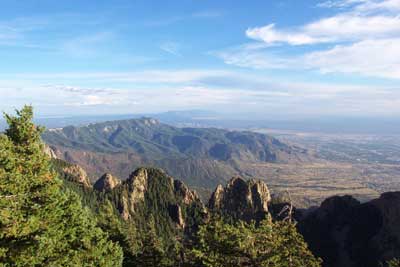
To the east (NE) are the Ortiz mountains, on the right, and Joe's very own Cerrillos Hills on the left.

And this is the "steel forest" immediately north of the public area.

For what it's worth, this column, at barely 2 years and 3 months, will soon exceed 70,000 words.
|
| 7/29/2005 |
William Livingston
The Livingston family, including Bill's father and mother, sister Ella and several other siblings journeyed west with the Blonger Bros., and remained close by them for many, many years. Yet we've never found them in the news, only in other sources. So who were they?
We have a special interest in this family. They were close to the Blongers. Who knows? There might be diaries or photos documenting the most interesting times of the Blonger Bros. lives.
Then there's this first-hand account of Niles's son:
http://historypreserved.com/vol_3_draper_historical_society,_2.htm
John Albert (Jack) Livingston was born April 17, 1881 in Salt Lake City to Niles Edward Livingston and Teresa Rosaleth Brown. When he was three years old, his mother died; he was passed around and eventually given to Elisabeth Gray and Charles Howell, who didn't have any children of their own. He lived with them until he could take care of himself. Jack took the name Howell.
Annie Pearl Butterfield, daughter of Elizabeth Jane Sharp and William Wellington Butterfield, was born September 18, 1890, in Union, Utah.
Jack married Annie June 28, 1906; they made their home in Taylorsville. He was a lineman for Utah Power and Light company. They had six children: Charles Albert on May 20, 1907; Venetta Elizabeth on May 30, 1909; Fern Pearl on May 7, 1911; Delpha Irene on July 23, 1913; Verla Annie on October 1, 1915 and Rhea Fay on June 10, 1918.
Annie's Aunt Zina, and her husband Fred Phelps, lived on a farm in Bluffdale; they visited them frequently. Jack had always wanted to live on a farm where he could have horses and cows and sheep. Fred talked Jack into buying the land next to his farm near 2700 West and 15200 South. They sold their nice home in Taylorsville.
On March 17, 1920, Jack, fastened their garage onto long poles, hitched the horses to it and dragged it along Redwood Road to Bluffdale; they settled it in a clearing on the south flat near the foot hills. It took them all day to accomplish this. Read more in the book. . .
Jeff gets the Bug
Brother Jeff has discovered the joy of old newspapers. He's sent several articles, some of which I'll be passing along. This is following the conviction of Lou's gang — sometimes referred to as the Florida gang, or Denver-Florida gang.
New York Times, June 2, 1923
DENVER BUNCO GANG GETS PRISON TERMS.
L. D. Blanger and 10 Aids Are Sentenced to 7 to 10 Years, 8 Others to 3
to 10 Years.
DENVER, Col., June 1 (Associated Press). - Nineteen members of Denver's
"million dollar bunco ring" got penitentiary sentences today. After
overruling their motion for a new trial, Judge George F. Dunklee in the
West Side Court, sentenced Lou D. Blonger, called the brains of the
band, and ten of his associates to serve from seven to ten years each
in the Colorado State Prison. Eight other members of the convicted
group of swindlers received sentences of from three to ten years each.
Blonger is 73 years old.
The defendants were convicted on three counts, charging conspiracy,
conspiracy to commit confidence gaming, and conspiracy to commit grand
larceny.
Those sentenced to serve from seven to ten years are: Blonger; A. W.
Duff, called the "first lieutenant" of the confidence men; Jack French,
who has wealthy relatives in Cleveland, Ohio; A. B. Cooper, Little
Rock, Ark.; George (Tip) Belcher; Thomas Beech; Steve J. Oleson; A. H.
Potts; Robert J. Davis; Walter Byland, and Louis Mushnick.
Those sentenced to serve from three to ten years are: Jack Hardaway;
John Allison; William Dougherty; John H. Foster; W. L. Straub; George
Walker; G. H. Williams and G. C. Bailey. The jury recommended leniency
for Hardaway, Allison and Dougherty.
Jeff got this photo of Simon's son Fred and his wife Emily's headstone.
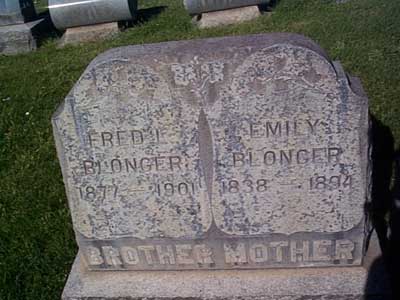
|
| 7/30/2005 |
In 1888, the Santa Fe New Mexican had a column of tidbits called Albuquerque Atoms.
|
| 7/31/2005 |
Con Caddigan
And then there's Con Caddigan.
Caddigan was a swindler and gold brick artist from way back, having first popped up in Deadwood, then Leadville and Denver, and finally Albuquerque in 1882. Like Nuttall, he is important to the story because he was involved in the only scam truly detailed by the Albuquerque press in 1882. Even then, the bust took place after Sam was fired.
And yet, other sources suggest quite plainly that Albuquerque was in the grip of a confidence gang at this time, and that certain crimes in the city were protected.
The question then becomes: If this was truly a gang, were the Blongers a part of the conspiracy? Did they use their positions as lawmen to protect the gang's operations?
Several things need to be considered: Is there a direct link between Caddigan, Nuttall, and the Blonger Bros.? Is Lou implicated in any bunco activity at that time? Did Sam protect the bunco gang's activities, and were Sam's troubles as marshal a result of such favors?
To suggest any of this is merely to hypothesize. A detailed examination of the recorded history of Sam's tenure reveals no direct accusation against Sam, only a weak-kneed "non-performance of duties" charge. And yet it seems unlikely to imagine the Blongers uninvolved in local bunco activities had they actually occurred. Or at least profiting somehow from the deliberate ignoring of same.
That said, we did find a few more clues in Albuquerque. Let's briefly reconstruct.
1876: Wild Bill Hickok is shot in Nuttall & Mann's #10.
1877?: Bill Nuttall runs the Bella Union Theater in Deadwood. Several sources state that the Blonger Bros. spent time in Deadwood, but the jury is still out. A journalist states in 1884 that Caddigan worked at some time with a gang of con men in Deadwood:
Clay Wilson and Con W. Caddigan, arrested at St. Louis July 1st with a lot of gambling implements and bunco material in their possession, are well known to the Western Detectives as smart confidence men and thieves. They are members of a gang that has worked Denver and Deadwood and the mining camps of Colorado and New Mexico, and have followed the Mexican Central road into Mexico.
1879: Nuttall opens the Metropolitan theater in Leadville. Lou is running the Novelty in nearby Georgetown. Sam runs for mayor of Leadville.
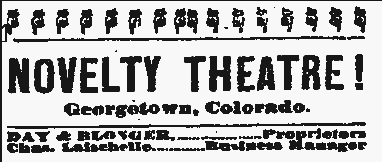
1881: Caddigan is already considering a move to New Mexico.
1882: In February, Sam becomes marshal. In April, Lou is accused of abetting a swindle by cashing a check. In May, Sam is accused, obliquely, of not attending properly to his business.
Come June, Caddigan and Nuttall are in town, and are noted as theater men from Leadville:
Albuquerque Evening Review, June 7, 1882
Billy Nuttles and Con Caddican, two of the most popular variety actors of Leadville, are in the city. They have some intention of leasing Smith & Snyder's opera house if they can make satisfactory arrangements, and if they succeed in this the boys will have some fine evenings of entertainment.
Sam is dismissed in July while away on business, and Archie Hilton is named acting marshal. A day later, Caddigan is appointed deputy sheriff, and then marshal.
Later in July, Lou directs, in an unknown capacity, an investigation into a jewelry heist.
In December, Sam is drafted as the Republican candidate for town constable. Opposing him are Con Caddigan and detective Tony Neis. Caddigan wins.
Not long after, Marshal Caddigan is implicated in a top and bottom swindle also involving Bill Nuttall, but gets off for lack of evidence. Tony Neis is charged with slander after publicly accusing a local shop of fronting for bunco men. Con Caddigan arrests him.
Caddigan eventually finds it best to leave town, and goes to Mexico to run a theater — but absconds with the money, leaving the company high and dry.
By 1884, Caddigan is in trouble for gold-bricking in St. Louis, and Nuttall is in the Albuquerque pokey for gambling.
An LA Times, dated May 27, 1911 tells how one C. W. Caddigan jumped bail after being charged with selling fake gold bricks to an old gent from Minnesota.
It goes on to tell us that Mr. Caddigan served as marshal of Albuquerque. The 1882 Morning Journal confirms that Con Caddigan was indeed the man who replaced Sam as deputy sheriff, and was then appointed marshal of New Albuquerque. But here we are told he was run out of town by the locals in 1883, "punctuating their warnings never to return with arguments more emphatic than words."
The article continues:
Caddigan, it is alleged, had turned some crooked jobs and the hustling western camp preferred his room to his company. He was associated in the New Mexico City with several notorious characters, two of them being the famous Blonger brothers, and one of them Soapy Smith, the great confidence shark, who was perhaps less clever, but a deal more real than J. Rufus Wallingford.
So, a pattern emerges, but we still find ourselves relying on inference and extrapolation.
A newly uncovered transcript of a speech given in 1933 by an old Albuquerque resident, Karl Snyder, includes great detail on life in New Town in 1882. Among other things, he states that there were plenty of bunco steeerers to be found, many of them peddling salted claims. He continues that Albuquerque did not have a reputation as a haven for con men for lack of a high-profile case.
The following article, published just prior to the Blonger's stint in Albuquerque, sheds a bit more light. It details the various ploys practiced by Albuquerque's many con men, confirming that this type of activity was already a daily occurrence in town. A crossroad like Albuquerque was valuable territory to the con man.
Albuquerque Daily Journal, November 13, 1881
Confidence Crooks.
The Way They Have Been Gulling the Greenies in Albuquerque.
Some of Their Brilliant Schemes for Swindling Their Victims.
Confidence men can be found in all cities of any size the world over. The sharper ones confine themselves to larger eastern cities and work for big game. Those who are not so well up in their profession take the old worn out games of their brethren in the east and come west to practice them on the unsophisticated. Albuquerque is at present well supplied with this class of swindlers, and it would not be amiss, under the circumstances, to give away some of their schemes. All classes of men fall victims to their wiles. The laborer, the business man and gentlemen engaged in their professions, are equally liable to find themselves minus a few dollars by confiding in some assuming gentleman. Of course a game which would make a laboring man give up his money would not work on a business or professional man, and vice versa. Few of those who get bitten ever say anything about it, but profit by their experience, and take good care not to allow it to occur again.
The laboring classes who have been roped in here, generally had what is called the "mill game" worked on them. Some business like, well dressed man will walk up to his victim and inform him that he owns a mill in the mountains near here, and that he wants to hire some help. He offers big inducements and greenie hires out to him. After he has gained the confidence of the man, his accomplice meets him and presents a bill against the mill. The mill owner finds that he has not quite enough cash in his pocket to settle, and confidently turns to his new employee and requests the loan of five or ten dollars for a short time. If the scheme works he takes the money and shakes the victim to go in search of another.
The "rush game" is practiced on business firms. A couple of sharpers rush into a store, make some trivial purchase and throw out a ten dollar bill in payment. They are in a great hurry and want their change as soon as possible. When the merchant or clerk turns to get the change, the bill is picked up by the sharpers, and relaced in their capacious pockets, and then they take the change as it is counted out to them. The storekeeper asks for the bill and both of the sharpers swear point blank that he has already received it, and as the swindlers have possession of the funds, they have the advantage of the argument and Mr. Merchant gets left.
Probably the thinnest swindle of all, which has been successfully worked in this city, is that known to the "profession" as the "mallet game." A carpenter, or an alleged carpenter, enters a store and leaves some tools for safe keeping until he returns or them. Among these is a mallet. After he is gone one of his partners comes in and slyly changes the mallets. Sharper No. 1, with sharper No. 3, come in soon after to get the tools. A glance at them shows that the mallet is not the one he had deposited. He mentions the fact to the proprietor of the store. A discussion is raised as to the relative value of the tools, which is followed by an offer on the part of sharper No. 3 to bet that the mallet is worth, say ten dollars, or about ten times its actual value. His bet is taken up by the clerk or some bystanders, as it is a sure thing. Mr. Sharper picks up the mallet, takes off the handle, and shows, in a small chamber, a sum of money neatly secreted. Of course the money makes the mallet valuable, and the confidence men win the bet.
These are only a few of the schemes practiced by the confidence men who are in the city. They have every imaginable device for gulling greenies, and there is no telling when you are not betting against a sure thing. The only advice the JOURNAL can give is, don't bet on another man's proposition, even if he will swear that black is white, for you are morally certain to lose.
The Journal is obviously not too impressed with its resident breed of con man. And who can blame them. The Mallet Game?
When Sam became marshal, he immediately evicted numerous "vags" and "holdups." Were some of them con men? Rival con men, perhaps, or just the scummiest, for the sake of appearances? One of those sent packing was a Soapy Smith confederate, the generally reviled Big Ed Burns.
|
July 2005
|
Genealogy - History - Gang - Posse - Evening Review
The Grafters Club - Blonger Bros. Fake Restaurant
|
Copyright Notice: Original material copyright 2003-2021 Scott Johnson and Craig Johnson. Other copyrights may apply to materials found herein. Our primary goal is to reintroduce the Blonger Bros. to the lexicon of the Wild West. We therefore encourage the use of our research, provided due credit is given.
https://www.blongerbros.com
|
|



